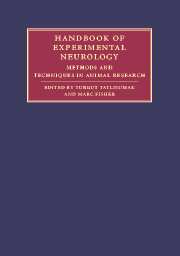Book contents
- Frontmatter
- Contents
- List of contributors
- Part I Principles and general methods
- 1 Introduction: Animal modeling – a precious tool for developing remedies to neurological diseases
- 2 Ethical issues, welfare laws, and regulations
- 3 Housing, feeding, and maintenance of rodents
- 4 Identification of individual animals
- 5 Analgesia, anesthesia, and postoperative care in laboratory animals
- 6 Euthanasia in small animals
- 7 Various surgical procedures in rodents
- 8 Genetically engineered animals
- 9 Imaging in experimental neurology
- 10 Safety in animal facilities
- 11 Behavioral testing in small-animal models: ischemic stroke
- 12 Methods for analyzing brain tissue
- 13 Targeting molecular constructs of cellular function and injury through in vitro and in vivo experimental models
- 14 Neuroimmunology and immune-related neuropathologies
- 15 Animal models of sex differences in non-reproductive brain functions
- 16 The ependymal route for central nervous system gene therapy
- 17 Neural transplantation
- Part II Experimental models of major neurological diseases
- Index
- References
9 - Imaging in experimental neurology
Published online by Cambridge University Press: 04 November 2009
- Frontmatter
- Contents
- List of contributors
- Part I Principles and general methods
- 1 Introduction: Animal modeling – a precious tool for developing remedies to neurological diseases
- 2 Ethical issues, welfare laws, and regulations
- 3 Housing, feeding, and maintenance of rodents
- 4 Identification of individual animals
- 5 Analgesia, anesthesia, and postoperative care in laboratory animals
- 6 Euthanasia in small animals
- 7 Various surgical procedures in rodents
- 8 Genetically engineered animals
- 9 Imaging in experimental neurology
- 10 Safety in animal facilities
- 11 Behavioral testing in small-animal models: ischemic stroke
- 12 Methods for analyzing brain tissue
- 13 Targeting molecular constructs of cellular function and injury through in vitro and in vivo experimental models
- 14 Neuroimmunology and immune-related neuropathologies
- 15 Animal models of sex differences in non-reproductive brain functions
- 16 The ependymal route for central nervous system gene therapy
- 17 Neural transplantation
- Part II Experimental models of major neurological diseases
- Index
- References
Summary
Introduction
The availability of advanced imaging techniques has revolutionized the evaluation of many clinical neurological disorders. Similarly, the availability of advanced imaging techniques has enhanced the utility of animal models related to the study of these disorders. Currently, the most available and useful imaging techniques in animal models of neurological disorders are those related to magnetic resonance imaging (MRI) applications, computerized tomography (CT), and positron emission tomography (PET). This chapter will introduce the basic concepts related to these various imaging modalities and then discuss their application to neurological disorders with a focus on acute ischemic brain injury.
Magnetic resonance imaging
A wide variety of MRI techniques are currently available for use in animals and patients. The range of MRI modalities and their main uses are provided in Table 9.1. The initial MRI modalities employed were T1- and T2-weighted imaging that evaluated the density of water proton spins. Water protons in relatively unrestricted fluid spaces have higher T1 and T2 values, while these protons in more restricted environments such as brain edema, hemorrhages, or tumors have lower values. These two MRI modalities are associated with an increase in interstitial water content of the brain, as seen with the development of vasogenic edema. Conventional T1 and T2 MRI have been used widely in clinical imaging for two decades and have also been used extensively in animal models of brain ischemia, tumors, traumatic injury, and multiple sclerosis (MS).
Information
- Type
- Chapter
- Information
- Handbook of Experimental NeurologyMethods and Techniques in Animal Research, pp. 132 - 146Publisher: Cambridge University PressPrint publication year: 2006
